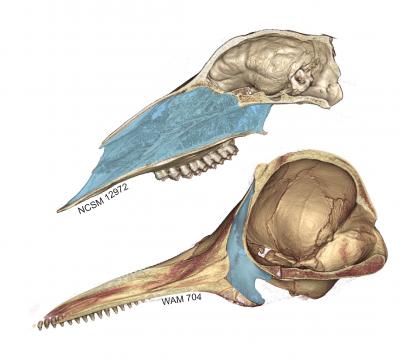Toothed and baleen whales show different patterns of blowhole development

Credit: Rachel Roston.
The two major types of cetaceans appear to have evolved their characteristic blowholes through different anatomical transformations, according to a study being presented at the American Association for Anatomy annual meeting during the Experimental Biology (EB) 2021 meeting, held virtually April 27-30.
Cetaceans, a group of marine mammals that includes whales and dolphins, evolved from ancestors that walked on land around 50 million years ago. Somewhere along the way, the forward-pointing nose shifted to an upward-pointing blowhole, making it easier for the animals to breathe air while swimming.
For the new study, researchers observed shifts in nasal passage orientation in spotted dolphin and fin whale embryos and fetuses. Both species initially develop a forward-pointing nose, like any other mammal, which gradually transforms into a blowhole by birth. Anatomical changes during prenatal development can provide clues about how certain traits evolved over time.
“The main difference we observed is in how the nostrils reach this position during prenatal development — there does not seem to be one way to do it,” said Rachel Roston, PhD, a postdoctoral fellow at the University of Washington and the study’s lead author. “The dolphin species and other toothed whales showed backwards bending of the skull, whereas the fin whale and other baleen whales showed changes in the occipital bone at the back of the skull.”
Researchers have previously studied other differences in the nasal passages of the two types of cetaceans; for instance, toothed whales have a single nostril whereas baleen whales have two. By focusing on the part of the skull that connects the nasal passage and the rest of the body, the new study examines previously unexplored territory at the intersection of nasal passage orientation and head-body alignment.
Roston says the work suggests that the two cetacean types may have evolved their blowholes through different developmental processes, though additional research, such as studies of the fossil record, would be needed to more rigorously test this hypothesis.
“Few, if any, other mammals have evolved such an extreme shift in nasal passage orientation and nostril position,” said Roston. “Understanding how developmental transformations lead to nasal passage reorientation during prenatal development helps us understand how changes to development can lead to the evolution of extreme and unique anatomical features.”
Roston will present this research in poster R4523 (abstract). Contact the media team for more information or to obtain a free press pass to access the virtual meeting.
Images available.
###
About Experimental Biology 2021
Experimental Biology is an annual meeting comprised of thousands of scientists from five host societies and multiple guest societies. With a mission to share the newest scientific concepts and research findings shaping clinical advances, the meeting offers an unparalleled opportunity for exchange among scientists from across the U.S. and the world who represent dozens of scientific areas, from laboratory to translational to clinical research. http://www.
About the American Association for Anatomy (AAA)
AAA is the professional home for an international community of biomedical researchers and educators focusing on the structural foundation of health and disease. Founded in 1888, the Association advances anatomical science through research, education, and professional development. http://www.
Find more news briefs and tipsheets at: https:/
Media Contact
Nancy Lamontagne
[email protected]




